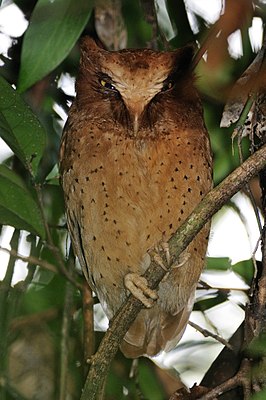Serendib scops owl
| Serendib scops owl | ||||||||||
|---|---|---|---|---|---|---|---|---|---|---|

Serendib scops owl |
||||||||||
| Systematics | ||||||||||
|
||||||||||
| Scientific name | ||||||||||
| Otus thilohoffmanni | ||||||||||
| Warakagoda & Rasmussen , 2004 |
The Serendib scops owl ( Otus thilohoffmanni ) is a species of the scops owl . It was discovered in 2001 in the Sinharaja Forest in Sri Lanka and scientifically described in 2004. Serendib is the old Arabic name for Sri Lanka and the art epithet honors the Swiss environmentalist Thilo Walter Hoffmann , who is one of the most prominent rainforest activists in Sri Lanka.
features
The Serendib scops owl reaches a size of 17 centimeters, a wing length of 128 to 140 millimeters and a tail length of 63 to 66 millimeters. Only one male has been caught so far, all other data on the taxon is based on field observations. The top is reddish-brown and mottled black everywhere. The feathers have no white spots, but there are some lighter areas around the black spots. The wing and tail feathers have reddish-brown outside flags and mostly blackish inside flags. The hand wings and tail feathers have wide, evenly arranged, reddish-brown and blackish bands. The chest is light reddish brown and fairly regularly speckled with blackish triangular spots. The belly and the underside of the tail are lighter than the chest and not speckled. The legs are feathered light reddish-brown up to half of the barrel ( tarsometatarsus ). The lower half of the barrel and the toes are featherless. The head is uniformly reddish-brown with whitish eyebrows. The reddish-brown face veil is not particularly prominent and has an inconspicuous edge. There are no tufts of ears; however, “false” tufts of ears become visible when the owl ruffles its plumage. The juvenile owls look similar to the adult owls. The large eyes are orange-yellow. The iris is surrounded by a striking black ring. The pupil is blackish with a narrow pink border. The wax skin is flesh-pink and the relatively long beak is white-ivory. The featherless areas of the thin legs and the toes are pinkish-white. The claws are white-ivory in color.
habitat
The Serendib scops owl is true to location and inhabits large areas with lowland rainforests at altitudes of 30 to 500 meters. These rainforests are very often secondary forests with dense undergrowth.
Way of life
The Serendib scops owl has a stealthy way of life. Your sleeping places are mainly in the lower tree level. Their calls can be heard at dusk; however, she does not go hunting until after dark. The diet consists mainly of insects, especially moths and beetles. It hunts near the ground or in the lower tree storey. In doing so, she usually uses horizontal or inclined branches from the lower levels of the trees as a seat guard. The couples defend their territory all year round. There is little information about the breeding biology. The Serendib scops owl presumably nests in tree hollows that were previously made by woodpeckers or bearded birds .
Existence and endangerment
Fewer than 100 specimens have been observed so far. Since little research has been done on this owl, no precise data is available about its population. BirdLife International estimates the population at 200 to 250 individuals. According to optimistic estimates, up to 1,000 specimens could possibly exist in five protected reserves. The IUCN classifies the species as "critically endangered" ( endangered ). The Serendib scops owl avoids forest areas that have an area of less than 8.2 km 2 . Loss of habitat through deforestation and the pressure of new settlers on the protected forests are continuing.
discovery
The Serendib scops owl is the first record of a new bird species in Sri Lanka since the Ceylon whistling thrush ( Myophonus blighi ) was discovered in 1868. After the Sinhalese ornithologist Deepal Warakagoda heard an unusual “poo-poo” call in the Kitulgala rainforest in 1995 , he managed to observe and photograph a specimen in the Sinharaja Forest Reserve on January 23, 2001. In addition to the reserves in Sinharaja and Kitulgala, there have been observations from the Ranakanda reserve in Morapitiya and from Eratna Gilimale.
literature
- Deepal H. Warakagoda and Pamela C. Rasmussen : A new species of scops-owl from Sri Lanka. Bulletin of the British Ornithologists' Club 124, No. 2, 2004: pp. 85-105. PDF full text
- Claus König & Friedhelm Weick: Owls of the World. 2nd Edition. Christopher Helm, London 2008. ISBN 978-0-7136-6548-2
Web links
- BirdLife Species Factsheet.
- photos
- Photos at www.naturlichter.de
- Otus thilohoffmanni inthe IUCN 2013 Red List of Threatened Species . Listed by: BirdLife International, 2012. Retrieved October 2, 2013.